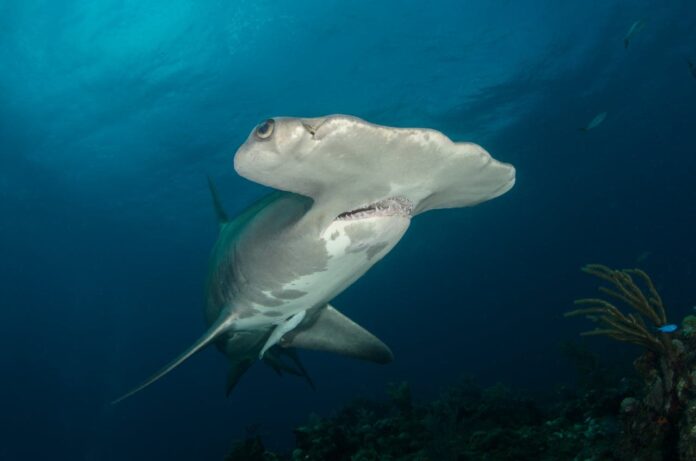Hammerhead sharks are one of the unique-looking faces with a distinctive head structure that we can easily recognize. You can find these sharks worldwide, and they prefer living in warm waters along coastlines and continental shelves. The interesting thing about hammerhead sharks is that they swim in schools during the day but hunt solitarily at night. Each hammerhead shark species is great and unique in its own ways, and we are going to discuss some today. Let’s take a look at the list below and don’t forget to share your thoughts with us.
1Bonnethead
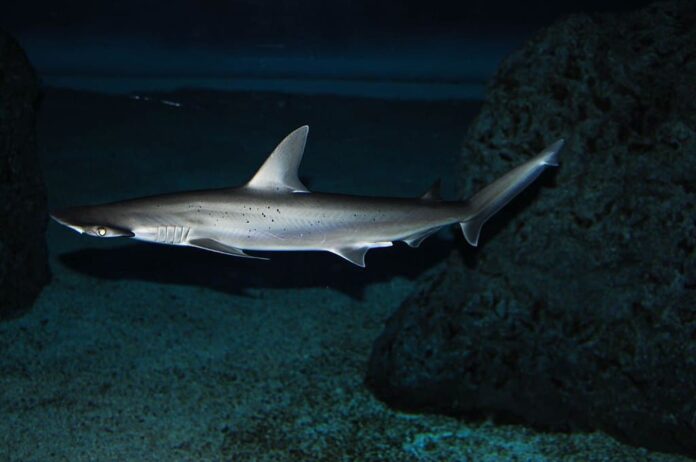
Bonnethead is one of the smallest members of the hammerhead shark family, and it is a very fascinating species. Many people know bonnethead because it is the only omnivorous shark species in the world. Even more interesting, it is also the only shark species known to display sexual dimorphism in the morphology of the head. Its head shape is unique among the species because it does not have a straight head with notched edges. A bonnethead has a broad and smooth spade-like head with a body that grows as long as 1.5 meters (5 feet). This hammerhead shark species occurs on both sides of the American coast, in the Atlantic and Pacific Oceans. It is abundant in the Gulf of Mexico and the littoral zone of the North Atlantic.
Within their ranges, these sharks reside on continental and insular shelves, over estuaries, reefs, and shallow bays. Those are also the areas where the bonnetheads spend their daytime feeding on crustaceans (their primary food source) and seagrasses. This tropical shark is active in warm waters where it swims in small groups of 5 to 15 individuals. However, they can swim in groups of hundreds or thousands during migration seasons. Meanwhile, in spawning season, these sharks tend to group by gender instead. Females will congregate in shallow waters to give birth during pupping season. Bonnethead sharks are considered harmless to humans since this species is rather shy so it often avoids us. So far there has been only one unprovoked attack on a human.
2Carolina Hammerhead
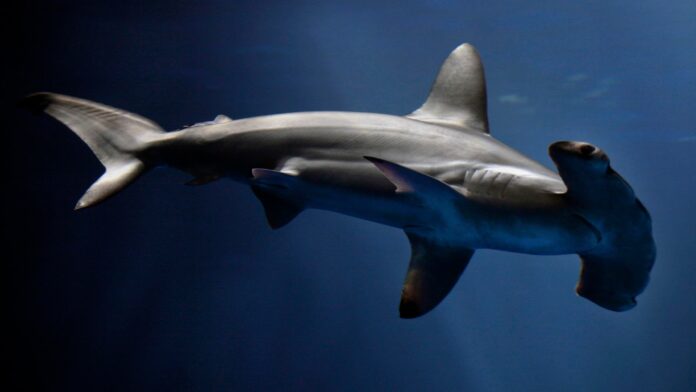
Discovered in 2013, Carolina hammerhead is one of the latest discovered shark species in the world. It received its name in honor of Carter Gilbert who unknowingly recorded its first known specimen in South Carolina back in 1967. Dr. Gilbert caught the first Carolina hammerhead shark specimen which he believed to be the scalloped hammerhead with 10 fewer vertebrae. Until 46 years later, it was confirmed that the hammerhead shark he caught was actually a new different species. That was because these two species look virtually identical to one another, and a little difference appears more as errors.
As a new and rare species, information about this hammerhead member is still not enough. Adult Carolina hammerheads can grow as long as 4 meters (13 feet) in length. So far, their ranges are offshore of the Carolinas in the Western Atlantic where they reside, breed, and give birth. In where they live, these hammerhead sharks feed mainly on bony fishes and cephalopods. Their diet also consists of crabs, lobsters, shrimps, rays, and other sharks. Although new, this species is also considered to be Endangered due to fishing for fins used in soups.
3Great Hammerhead
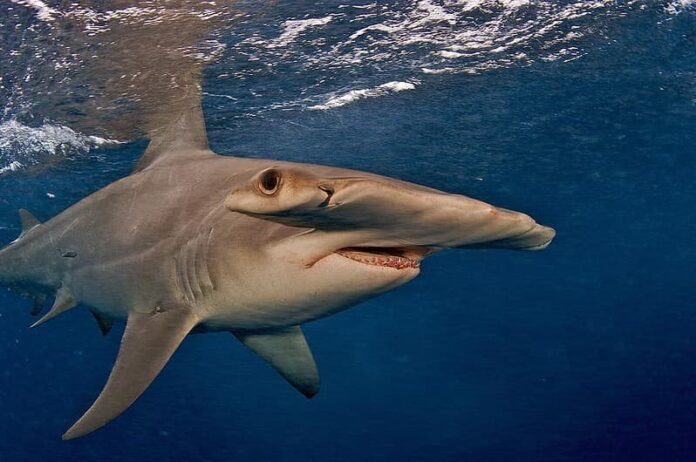
Here we have the largest hammerhead shark species that can reach up to 6.1 meters (20 feet) in length. The great hammerhead can be distinguished from other species by its enormous size and nearly straight hammer-shaped head. The head has a prominent indentation in the middle that is the only character that this species possesses. These apex predators have long serrated teeth that they use to chomp on the prey that they can find. These incredible hunters have electrical receptors on their heads that allow them to sense potential prey even if it hides in the sand. Their common food are cephalopods, crustaceans, stingrays, and other sharks. When feeding on rays, they use the sides of their heads to pin down their favorite meal while feeding on their wings. On top of that, they are cannibalistic because they would eat their own species if need be.
Great hammerhead sharks are solitary, and they live in coastal and warm waters that are 20 degrees Celsius or higher worldwide. As viviparous, great hammerhead sharks give birth to live young from 6 to 42 pups once every two years. With a faster growth rate, this hammerhead shark species reach maturity between 5 and 9 years old. Without threats, a great hammerhead shark can live up to 44 years or longer in the ocean. Although staying on top of the food chain without predators, great hammerhead sharks are vulnerable to overfishing. They are caught commercially for their fins in longlines and incidentally with other smaller fishes in the nets. Because of their large fin size, great hammerheads are the main targets of the global shark fin trade. This is why this species is threatened and close to endangered as we are speaking.
4Scalloped Bonnethead
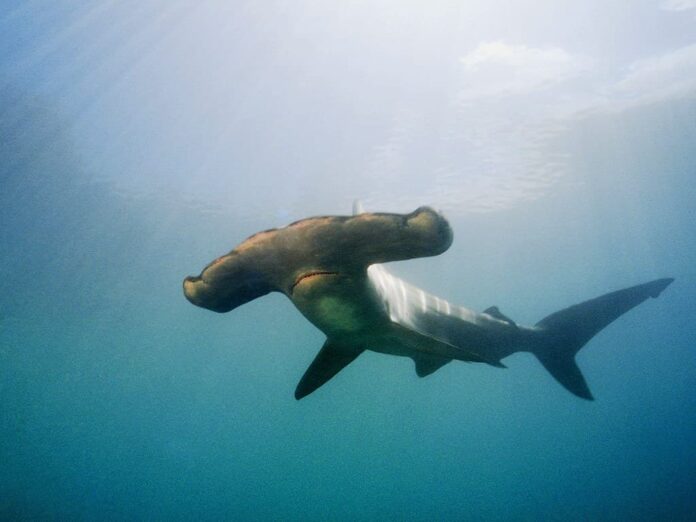
The scalloped bonnethead is one of the rare species whose information is not so plenty. This hammerhead shark species also goes by the name of “crown shark” and “mallethead shark” due to its appearance. It literally has a mallet-shaped head that is moderately wide and elongated lengthwise along with a broadly arched front margin. Also, it is the smallest hammerhead shark species that measures up to 92 centimeters (3 feet) long. Scalloped bonnethead sharks frequent inshore habitats over soft bottoms like gravel, mud, and sand in tropical to warm waters worldwide.
Their most common locations are in the Eastern Pacific Ocean from Mexico to Peru. Usually, they live and swim at a depth of 100 meters in the oceans but also enter estuaries and mangroves. In those areas, they feed on bony fishes, cephalopods, crustaceans, echinoderms, and mollusks that they can find. Their arched mouth and wide cephalofoil are helpful for them to crush crustaceans and mollusks. With a low and declining population, this species is Near Threatened with the potential to become Vulnerable in the future.
5Scalloped Hammerhead

The appearance of this shark species makes it look absolutely different from all other fishes. They have a wide and hammer-shaped head along with notches along the front edge, hence their name. This species also goes by other nicknames like a bronze hammerhead shark, kidney-headed shark, and southern hammerhead shark. They can grow up to 3.5 meters (11 feet), and they are aggressive predators that gain advantages from the shape of their heads. The nostrils and widely spaced eyes help them to find prey around or near them successfully every time. On top of that, they also have special sensory cells that they use to detect the electric field of other fishes. These sharks have incredible senses that allow them to locate prey even if they are buried under the sand.
Before, scalloped hammerhead sharks form very large schools of hundreds of adults which made them vulnerable to targeted fishing. Now, they still live in large groups occasionally but they tend to live solitarily most of the time. Despite their timid nature, scalloped hammerheads are potentially dangerous sharks because they will attack even unprovoked sometimes. These sharks display threat postures when closely approached by divers sometimes while other times they show no aggressive behaviors. Just like most hammerhead sharks, their fins and hides are highly valuable and they are very vulnerable to commercial fishing. This species is Critically Endangered at the moment, and it is close to extinction soon in the future.
6Scoophead

This is another hammerhead shark species with little information that scientists are yet to discover. Scoophead hammerhead sharks inhabit inshore, shallow, and tropic waters of the Eastern Ocean and Western Atlantic Ocean. This species is distinguished by its moderately broad head with an arched margin just like the scalloped bonnethead. The differences are that the scoophead has a broadly arched mouth, a deeply concave anal fin, and a shorter snout than scalloped bonnethead.
Similar to the bonnethead, the scoophead can grow up to 150 centimeters (5 feet) long. These two actually coexist together without competing with each other for food and habitats. Scoophead hammerhead sharks feed on flounders, octopuses, squid, and small elasmobranchs. This species is one of the main targets of commercial fishing that sells them as fresh fish or turns them into fishmeal. Apart from those, scoophead is also a common bycatch that plays a part in threatening their population.
7Smalleye Hammerhead
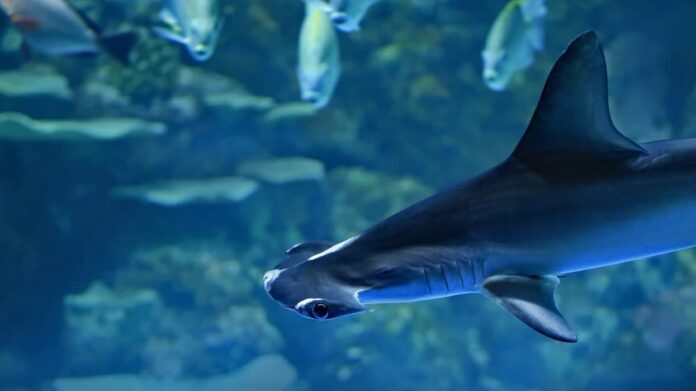
Goes by other names such as curry shark or golden hammerhead, smalleye hammerhead has everything its names describe. A hammerhead of this species has small eyes along with bright golden colors on its fins, heads, and sides. The unique yellow-orange pigments on their body may be from the penaeid shrimp which is their main food as juveniles. When they mature, they feed on sea catfish and their eggs but the pigments still remain although they change their diet. As for their small eyes, they evolved due to their preference for muddy coastal waters. This simply helps them to see better without affecting their vision. Their length is normally around 1.3 meters (4.3 feet), making them one of the small hammerhead shark species.
This species is common in shallow coastal waters of the western Atlantic Ocean, especially in muddy habitats. At the same time, this hammerhead species can also tolerate brackish water if they need to be in that environment. In those regions, adult males and juveniles swim in schools while adult females are solitary. Being one of the most abundant sharks within its range, this hammerhead species is an important bycatch of artisanal gillnet fisheries. Not different from most hammerhead sharks, this one is also harmless and timid to humans. They neither attack nor have an interest in eating us, but they often fall victim to many commercial fishing nets. Because of overfishing in recent years, this species is now Critically Endangered.
8Smooth Hammerhead

With a flattened and laterally extended hammer-shaped head without an indentation, a smooth hammerhead is just the perfect name for this species. They have round heads that give them superior depth perception along with a 360-degree view of the surroundings. This species is the second largest hammerhead shark after the great hammerhead shark, growing up to 5 meters (16 feet) long. Due to their size, it is not a surprise to learn that they are active predators in the oceans. Smooth hammerhead sharks prey on a wide range of bony fishes and invertebrates as well as rays and sharks. Besides those, they also feed on cephalopods, crustaceans, and sea snakes like other hammerhead sharks.
Another difference between them is that they are potentially dangerous with a few attack records on humans, resulting in 2 fatalities. Even if encountering one of them is not so common, they are the species that swimmers should watch out for. You can find smooth hammerhead sharks in temperate waters worldwide at medium latitudes which are different from other hammerheads. Throughout their ranges, their fins are extremely valuable for shark fin soup; hence overfishing of this species. Fishermen catch them and sell their meat fresh, dried, salted, or smoked although there are reports of poisoning. Some use their liver oil for vitamins, their offal for fishmeal, their skin for leather, and other uses in Chinese medicine.
9Winghead Shark
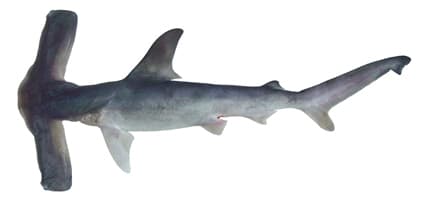
Slender body but a wide head, the cephalofoil of a winghead shark can be as wide as half of its total body length. Probably looks weird compared to other members of the family, this shape actually beneficial for them in the water. Winghead hammerhead sharks have amazing binocular vision thanks to the wide spacing of their eyes. On top of that, these hammerhead sharks have extremely long nostrils that provide better odor detection and tracking. This species inhabits shallow coastal waters of the central and western Indo-Pacific where they feed on bony fishes, cephalopods, and crustaceans. Winghead hammerhead sharks are harmless to humans while we are a threat to the decline of their population. Fishermen fish them for not only their fins but also liver oil and meat for fishmeal and food. In fact, this species has been listed as Endangered since 2016 until now due to overfishing.
Related Post: Largest Sharks In The Marine

